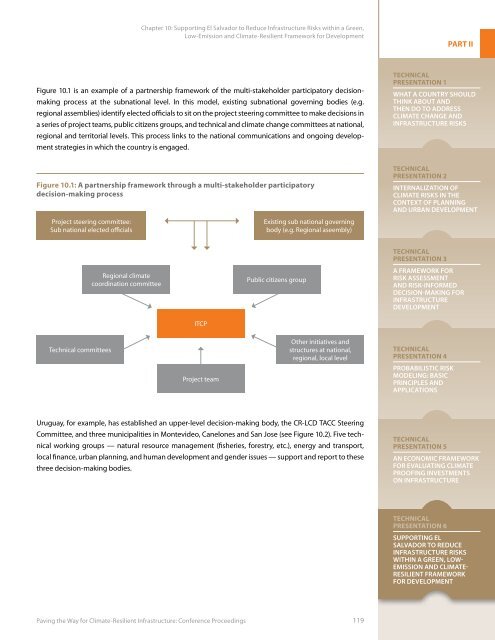Chapter 10: Supporting El Salvador to Reduce <strong>Infrastructure</strong> Risks within a Green,Low-Emission and <strong>Climate</strong>-<strong>Resilient</strong> Framework <strong>for</strong> DevelopmentThis presentation focuses on this five-step process as a whole, <strong>the</strong> interconnection among <strong>the</strong>se stepsand <strong>the</strong> support that <strong>UN</strong>DP is providing to implement <strong>the</strong>m.What does <strong>UN</strong>DP provide to countries?‘‘<strong>UN</strong>DP provides awide range of services— knowledge,data and analysis,training, projectidentification andaccess to financing —to facilitate countries’implementation ofGreen LECRDS.’’<strong>UN</strong>DP provides a wide range of services — knowledge, data and analysis, training, project identificationand access to financing — to facilitate countries’ implementation of Green LECRDS. First, <strong>UN</strong>DPsupports knowledge exchange of lessons learned and best practices within and between regions.<strong>UN</strong>DP also provides data and analysis, supporting bio-physical and socio-economic assessments and<strong>the</strong> development of scenarios specifically designed to in<strong>for</strong>m national and subnational climate changestrategies, action plans and related products through <strong>the</strong> provision of methodological tools and techniques.In addition, <strong>UN</strong>DP offers training on <strong>the</strong> use of <strong>the</strong>se tools and on design of integrated GreenLECRDS. <strong>UN</strong>DP also facilitates <strong>the</strong> selection of projects in support of Green LECRDS and <strong>the</strong> identificationof appropriate regulatory and financial instruments (i.e. public policy and public and private investmentprojects <strong>for</strong> infrastructure). Finally, <strong>UN</strong>DP provides technical assistance to facilitate access to newfinancial mechanisms. Given <strong>the</strong> difficulty of attaining credibility at <strong>the</strong> decision-making level, <strong>the</strong>seservices help to meet <strong>the</strong> need <strong>for</strong> cross-ministerial support by streng<strong>the</strong>ning relationships amongelected officials via steering committees and sustaining project approach via technical working groups.Step 1:Developing a Multi-Stakeholder Planning ProcessThe first step in preparing Green LECRDS — developing a multi-stakeholder planning process — emphasizes<strong>the</strong> cross-sectoral nature of <strong>the</strong> Green LECRDS approach. This process includes undergoing internalpreparation and stocktaking exercises; raising awareness among national and subnational authorities;identifying and establishing a decision-making structure (e.g. steering committee, project coordinatingunit, sectoral working groups); and identifying/establishing a multi-stakeholder consultative process toidentify priority options and develop a Green LECRDS roadmap.The first step in <strong>the</strong> Green LECRDS process should consider <strong>the</strong> following activities.Establish Green LECRDS project team and project coordinator;Review and compile in<strong>for</strong>mation on existing climate assessments and plans, existing projects,policies, funding sources, key authorities and financial and technical experts, i.e. map key climateissues, opportunities and stakeholders;Establish Green LECRDS steering committee (using existing committees and structures whenpossible) composed of high-level elected officials and civil servants in sectoral ministries to ensureappropriate level of policy and political involvement;Identify and create policy and technical working groups (e.g. finance, energy, agriculture, <strong>for</strong>estry,urban development and transport, etc.) composed of representatives from national/regional/localauthorities, sectoral ministries, private sector, non-governmental and community organizations, ando<strong>the</strong>r civil society entities;Identify technical capacity needs and implement training; andPut in place communications and awareness-raising strategy directed towards a wide range ofauthorities, partners, and stakeholders.118<strong>Paving</strong> <strong>the</strong> <strong>Way</strong> <strong>for</strong> <strong>Climate</strong>-<strong>Resilient</strong> <strong>Infrastructure</strong>: Conference Proceedings
Chapter 10: Supporting El Salvador to Reduce <strong>Infrastructure</strong> Risks within a Green,Low-Emission and <strong>Climate</strong>-<strong>Resilient</strong> Framework <strong>for</strong> DevelopmentPART IIFigure 10.1 is an example of a partnership framework of <strong>the</strong> multi-stakeholder participatory decisionmakingprocess at <strong>the</strong> subnational level. In this model, existing subnational governing bodies (e.g.regional assemblies) identify elected officials to sit on <strong>the</strong> project steering committee to make decisions ina series of project teams, public citizens groups, and technical and climate change committees at national,regional and territorial levels. This process links to <strong>the</strong> national communications and ongoing developmentstrategies in which <strong>the</strong> country is engaged.TechnicalPresentation 1What a Country ShouldThink About andThen Do to Address<strong>Climate</strong> Change and<strong>Infrastructure</strong> RisksFigure 10.1: A partnership framework through a multi-stakeholder participatorydecision-making processProject steering committee:Sub national elected officialsExisting sub national governingbody (e.g. Regional aseembly)TechnicalPresentation 2Internalization of<strong>Climate</strong> Risks in <strong>the</strong>Context of Planningand Urban DevelopmentRegional climatecoordination committeePublic citizens groupTechnicalPresentation 3A Framework <strong>for</strong>Risk Assessmentand Risk-In<strong>for</strong>medDecision-Making <strong>for</strong><strong>Infrastructure</strong>DevelopmentITCPTechnical committeesProject teamO<strong>the</strong>r initiatives andstructures at national,regional, local levelTechnicalPresentation 4Probabilistic RiskModeling: BasicPrinciples andApplicationsUruguay, <strong>for</strong> example, has established an upper-level decision-making body, <strong>the</strong> CR-LCD TA<strong>CC</strong> SteeringCommittee, and three municipalities in Montevideo, Canelones and San Jose (see Figure 10.2). Five technicalworking groups — natural resource management (fisheries, <strong>for</strong>estry, etc.), energy and transport,local finance, urban planning, and human development and gender issues — support and report to <strong>the</strong>sethree decision-making bodies.TechnicalPresentation 5An Economic Framework<strong>for</strong> Evaluating <strong>Climate</strong>Proofing Investmentson <strong>Infrastructure</strong>TechnicalPresentation 6Supporting ElSalvador to Reduce<strong>Infrastructure</strong> Riskswithin a Green, Low-Emission and <strong>Climate</strong>-<strong>Resilient</strong> Framework<strong>for</strong> Development<strong>Paving</strong> <strong>the</strong> <strong>Way</strong> <strong>for</strong> <strong>Climate</strong>-<strong>Resilient</strong> <strong>Infrastructure</strong>: Conference Proceedings 119
















